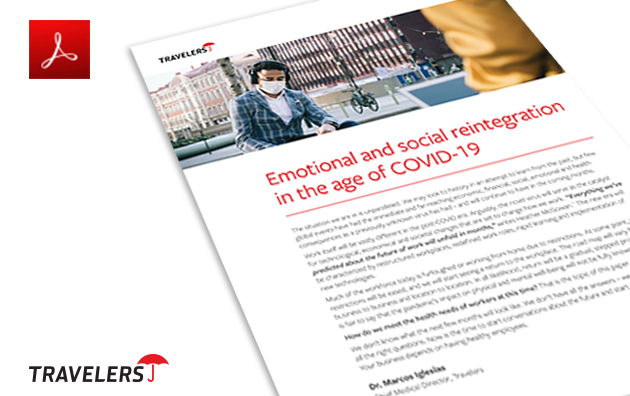Supporting Workplace Mental Health Post COVID-19

(SPEECH)
[MUSIC PLAYING]
(DESCRIPTION)
Dr. Marcos Iglesias.
(SPEECH)
MARCOS IGLESIAS: I hear a lot of people today talking about returning to work as a new normal. These are uncertain times. And we all know that stress can cause not only poor work performance, but can also have unintended health consequences. We need to consider the social and emotional well-being of those employees. There are going to be employees who have a hard time readjusting to the workplace, and I think it's crucial that supervisors are trained in how to identify these employees that have perhaps some challenges.
A simple way of doing that is asking, are you OK? No one has the playbook, but clear, frequent, and honest communication is going to win the game. Truly caring about your employees, about their physical well-being, their emotional well-being, is paramount in this day and age.
(DESCRIPTION)
Travelers dot com.
As employers prepare post-COVID-19 workplaces, supporting employees’ mental health can be as critical as creating a safe physical environment. Safety measures, such as sanitizing protocols and respiratory hygiene, are vital considerations for physical wellness. Taking a broader view of employee health that also includes emotional and social wellness can help employees manage uncertainty, engage in the workplace and adjust to a “new normal.”
Focusing on mental health is especially important during the readjustment phase. Employees may bring new stressors after weeks of sheltering in place that employers need to consider – from fear of infection at work to personal issues, such as child care concerns or substance abuse. Some may have delayed medical care, while others may be feeling financial stress or mourning lost loved ones. Others may be feeling the toll on their mental health in the form of anxiety, sleeplessness or depression.
Emotional and social reintegration in the age of COVID-19
“These uncertain times are stressful, and we know that stress can lead to poor performance and poor health,” said Dr. Marcos Iglesias, Medical Director at Travelers. “Now is the time to start conversations about the future and drafting a roadmap that works for your organization.”
As COVID-19 restrictions are gradually lifted, recognizing employees’ emotional and social health can help them reintegrate into the workforce and allow employers to offer additional resources when needed. Here are some strategies to help support mental health as employees return to work:

Emotional and Social Reintegration in the Age of COVID-19 [White Paper]
As employees return to work, it’s important to consider their physical, mental and social well-being.
1. Practice clear and frequent communication
Communicating with employees about plans to reopen can help keep them engaged and provide a sense of normalcy. Employees will want to hear about their company’s response plans, from social distancing to wearing personal protective equipment (PPE), as well as details about workforce and financial stability.
“It is important for employees to know what to expect as they return to the workplace,” Dr. Iglesias said. “That can help remove some of the uncertainty and reassure employees that you have their best interest in mind.”
When you share public health and safety information with employees, it should come from credible sources, such as the Centers for Disease Control (CDC), state health departments, and reputable medical organizations and journals.
2. Train supervisors to recognize at-risk employees
While many employees will be fine once they return to work, there may be some who have a harder time reentering the workplace and readjusting. Supervisors and managers can play a critical role in communicating with employees, providing stability and recognizing signs of distress. A recent study shows that 57% of workers are comfortable with their manager asking them about their mental health and 41% want their manager to proactively ask them.1
It’s crucial that supervisors and managers are trained in how to recognize employees who may be in distress and to know when and how to intervene. A simple, “Are you OK?” may open the door to better communication and provide an opportunity to gauge an employee’s mental health risk.
Supervisors can also create a welcoming environment for employees who may be returning in a modified duty role or who may have recovered from COVID-19 and may fear being stigmatized. Setting expectations and having clear communication can help these employees readjust to the workplace.
3. Evaluate flexible work arrangements
Employers may want to consider flexible work arrangements, such as adjusted schedules and remote working when possible. These may be necessary during reintegration to reduce stress for those dealing with personal and family issues, such as school closures or caring for loved ones. Companies may also need to reconsider their policies for paid time off, sick leave, leaves of absence, disability and bereavement, based on unique situations that their employees face. Continuing the open communication once employees return can help address challenges and identify solutions.
4. Consider workplace accommodations
Returning to work may create anxiety for some due to social proximity, especially when using shared workstations, shared dining space and food prep areas. Employees may ask for accommodations, such as separate work areas, physical barriers, face masks, PPE, cleaning equipment and working from home. This may be especially important for certain employees, such as those with chronic medical conditions and those over age 60.
5. Provide access to mental health resources
Employers must have available mental health resources for employees in need. This may take the form of an Employee Assistance Program (EAP) or a referral to external organizations that can provide crisis intervention, counseling or other assistance. Easy access to and promotion of a company’s EAP can help provide many helpful resources – not just mental health – to employees in need.
The COVID-19 pandemic has activated a surge in the use of telehealth, including remote and virtual interactions between individuals and healthcare providers. Access to telehealth can be an important part of an effective strategy for facilitating care to employees post COVID-19, and may offer an efficient alternative to in-person rehabilitation, addiction and mental health appointments. Resilience training may also help employees feel more empowered as they return to work.
There may be cases when urgent intervention is needed: suicide risk and threats of violence. Employees need to know how to identify this risk and what to do in these crisis situations, and providing them with a plan is imperative.
Working with Travelers
With the unprecedented nature of the pandemic, there is no defined playbook for helping employees through post COVID-19 health challenges. “What we do know is that clear, frequent, honest communication is going to win the game,” Dr. Iglesias said. “Truly caring about your employees and your employees’ health is going to be paramount.” Demonstrating that care with specific actions is the key way companies can effectively communicate their support to employees.
As the leading workers compensation carrier, Travelers helps employers protect the health and safety of their employees throughout their careers. Looking at each employee as an individual has proven to help recognize barriers that might interfere with an individual’s recovery from a work-related injury. Recognizing and removing these barriers can help employees return to work sooner. To learn more, talk to your independent agent.
Source
1 Qualtrics, 2020.



